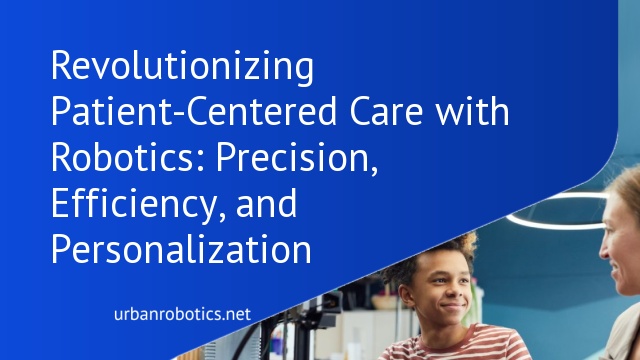Understanding Patient-centered Care
Patient-centered care focuses on respecting patients’ values, preferences, and expressed needs. This approach tailors healthcare to individual patients, ensuring their experiences and outcomes take priority. Engaging patients in their own care decisions enhances satisfaction and trust.
Effective patient-centered care requires communication and collaboration among healthcare teams. It emphasizes empathy, accessibility, and comprehensive information sharing. When healthcare providers understand patients’ unique circumstances, they can offer more personalized treatment plans.
Examples of patient-centered care include involving patients in treatment planning for chronic diseases and customizing physical therapy sessions. These practices ensure that we address specific health goals and personal limitations, improving adherence and outcomes.
With the integration of advanced robotics, patient-centered care reaches new heights. Robotic systems assist in delivering precise treatments aligned with patients’ needs, such as performing tailored surgeries or providing personalized rehabilitative exercises. This synergy of technology and empathy elevates patient-centered care in modern medicine.
The Role Of Robotics In Healthcare
Robotics in healthcare is transforming patient care, enhancing precision, and improving efficiency. With these advancements, patient-centered care is reaching new heights.
Benefits Of Robotics In Healthcare
Robots offer several benefits in healthcare. Surgeons use robotic systems for minimally invasive surgeries which reduce recovery times and minimize incision sizes. Rehabilitation robots provide personalized physical therapy exercises, speeding up recovery. Robotic companions assist elderly patients, offering social interaction and monitoring health. These innovations prioritize patient needs, increasing satisfaction and outcomes.
Challenges And Limitations
While robotics offers many benefits, challenges still exist. High costs of robotic systems limit widespread adoption, especially in smaller healthcare facilities. Technical issues and the need for specialized training can hinder efficient use. Additionally, concerns about data privacy and security are prominent due to the integration of robotics in medical settings. Addressing these limitations will require strategic investments and collaboration across the healthcare sector.
Robotics Enhancing Patient-centered Care
Robotics in healthcare is transforming how we deliver patient-centered care. Advanced robots are making treatments more personalized, improving monitoring, and enhancing rehabilitation.
Personalized Treatments
Robotics enables precise, customized treatments based on individual patient data. In oncology, robots assist in tailored radiation therapies by targeting tumors with high accuracy, minimizing damage to surrounding tissues. In orthopedics, robots perform patient-specific joint replacements, using pre-operative planning and real-time feedback during surgery. Personalized robotic interventions lead to better outcomes and faster recovery times.
Improved Patient Monitoring
Advanced robotic systems enhance patient monitoring by continuously gathering real-time data. In intensive care units, robots equipped with sensors track vital signs like heart rate and oxygen levels, alerting staff to any anomalies. In home healthcare, robotic devices monitor chronic conditions, sending data to healthcare providers for ongoing assessment. These advancements allow for timely interventions, reducing hospital readmissions.
Enhanced Rehabilitation
Robotic devices are revolutionizing physical rehabilitation with precise, repeatable movements. Exoskeletons aid patients recovering from strokes, providing support and enabling mobility. Robotic therapy systems customize exercise programs, adjusting resistance and movement patterns to the patient’s progress. These technologies ensure consistent therapy, leading to improved muscle function and faster rehabilitation.
Real-world Applications And Case Studies
Robotics in patient-centered care has seen significant real-world deployments. These instances showcase improvements in treatment quality and patient satisfaction.
Successful Implementations
Robotic-assisted surgeries, including prostatectomies and hysterectomies, enhance precision and reduce recovery times. For example, the Da Vinci Surgical System enables surgeons to perform complex procedures with high accuracy. In rehabilitation, devices like the Lokomat facilitate gait training for stroke patients. Hospitals using TUG robots for medication delivery report fewer errors and increased efficiency. Such implementations demonstrate their potential in enhancing healthcare delivery.
Patient Outcomes
Patients benefit significantly from robotic interventions. For instance, robotic surgeries result in fewer complications and quicker recovery. According to a study by the National Institutes of Health, patients undergoing robotic-assisted prostate surgery experienced less blood loss and shorter hospital stays. Robotic rehabilitation improves muscle function and reduces recovery times for stroke survivors. The integration of continuous patient monitoring ensures prompt response to health changes, leading to better overall outcomes and higher patient satisfaction.
Future Prospects Of Robotics In Patient Care
Robotics in patient care has significant potential for growth. Developments in artificial intelligence (AI) and machine learning (ML) enable robots to perform more complex tasks and adapt to patient needs. AI-powered robots can identify patterns in patient data for personalized treatments. For instance, a robot analyzing patient records could predict potential health issues, allowing for preventative measures.
Telemedicine also benefits from robotic advancements. Robots equipped with cameras and sensors facilitate remote consultations, especially in underserved regions. Surgeons could conduct remote surgeries using robotic systems, expanding access to expert care.
Exoskeletons represent another advancing area. These devices assist patients with mobility impairments, enhancing rehabilitation and daily activities. Future models may offer improved integration with neural networks for better control.
Collaborations between tech companies and healthcare institutions drive innovation. Investment in robotics R&D continues to grow. We should expect more versatile and autonomous robotic systems to enter patient care settings.
Addressing cost and technical barriers remains crucial. Strategic investments and cross-disciplinary efforts can expedite the adoption of these technologies, enhancing overall patient care and outcomes.
Conclusion
Patient-centered care is being transformed by the integration of robotics. These technologies prioritize precision and efficiency while addressing individual patient needs. Robotic-assisted surgeries personalized therapies and continuous monitoring are just a few examples of how robotics is enhancing patient outcomes and satisfaction.
As AI and ML continue to advance the potential for even more sophisticated and effective robotic solutions grows. Collaborations between tech companies and healthcare institutions are driving innovation ensuring that the future of patient care will be even more personalized and efficient.
Strategic investments and cross-disciplinary efforts are key to overcoming current barriers. By embracing these technologies we can look forward to a future where patient-centered care is more accessible and effective than ever.





